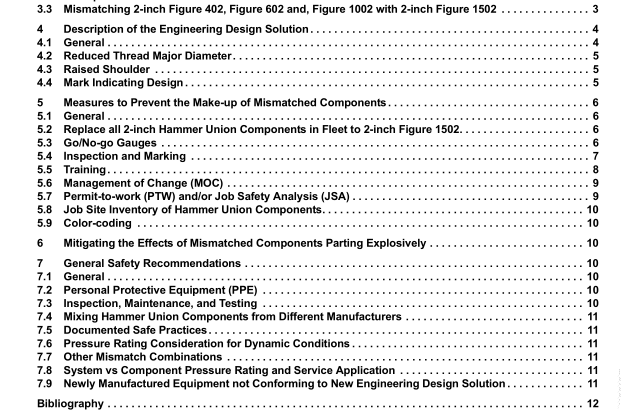API RP 7HU1:2009 pdf free download.Safe Use of 2-inch Hammer Unions for Oilfield Applications
These hammer union components have a history of failing under pressure due to incorrect matching of components (pressure ratings and/or incompatible geometry). The list of hammer union components that can be incorrectly matched is not meant to be all-inclusive. Users should establish controls to ensure hammer union combinations are safe, especially when more than one manufacturer’s components are used.
3.2 Example of the Hazard The mismatching of either the female 2-inch Figure 402, female 2-inch Figure 602 or the female 2-inch Figure 1002 hammer union component (sub) with a male 2-inch Figure 1502 hammer union component (wing nut) is a worldwide issue in the industry and can cause serious incidents, including fatalities. Complete and proper make-up of hammer union components is required to attain the rated working pressure of the equipment.
The root cause of the mismatch is that the 2-inch Figure 402, 2-inch Figure 602 and 2-inch Figure 1002 unions were designed with the same thread pitch as the 2-inch Figure 1502 and the female subs have a major (external) thread diameter that is just large enough to engage the minor (internal) diameter of the 2-inch Figure 1502 wing nut internal acme thread. Consequently, although these mismatched hammer union components (2-inch Figure 1502 wing nut with a 2-inch Figure 402, Figure 602 or Figure 1002 female sub) may fully make-up and hold some level of pressure, an explosive failure of the mismatched unions will occur well below the rated working pressure of any of the components, putting people and property at risk. See IADC Alerts 98-01, 99-33, 00-15, 03-16, and 06-01 for additional information.
3.3 Mismatching 2-inch Figure 402, Figure 602 and, Figure 1002 with 2-inch Figure 1502 A 2-inch Figure 1502 wing nut can be threaded onto a 2-inch Figure 402, 2-inch Figure 602 or 2-inch Figure 1002 female sub as shown in Figure 1. Although the acme thread diameters are different, the pitch (number of threads per inch) is the same. The resulting mating overlap of the threads between these mismatched hammer union components will not hold pressure. Consequently, the mismatch combinations will make-up and appear to be pressure tight (and may even hold significant pressure), however they will fail well below the rated working pressure of either of the union components (male or female). The failure will be explosive, putting people and property at risk.
4 Description of the Engineering Design Solution
4.1 General The recommendations described herein are intended to be an engineering solution to the mismatch problem by preventing the inadvertent make-up of a female 2-inch Figure 402, 2-inch Figure 602 or 2-inch Figure 1002 sub with the wing nut of the 2-inch Figure 1502 hammer union. Manufacturers are encouraged to implement this engineering solution on all newly manufactured hammer union components. Users should utilize components and assemblies that implement this solution. The engineering design solution involves a change of the 2-inch Figure 402, 2-inch Figure 602 and 2-inch Figure 1002 female sub in three different areas as follows:
a) reduced thread major diameter,
b) raised shoulder,
4.2 Reduced Thread Major Diameter The major diameter of the external acme thread on the 2-inch Figure 402, 2-inch Figure 602 and 2-inch Figure 1002 female subs shall be reduced so as not to exceed, and thus not allow engagement with, the minimum minor diameter of the internal acme thread of the 2-inch Figure 1502 wing nut. Figure 2 illustrates a reduction of the external acme thread by comparing the original design major diameter (on left with no raised shoulder) with the reduced major diameter (on right with raised shoulder).
4.3 Raised Shoulder A raised shoulder shall be designed into the area behind the threads of the 2-inch Figure 402, 2-inch Figure 602 and 2-inch Figure 1002 female subs to provide a visual indicator of the redesign. This raised shoulder allows the users and suppliers to readily separate their inventory of hammer union components between the original design and the new design that is specifically redesigned to prevent mismatching. Figure 3 shows a comparison of the original geometry without the raised shoulder (on the left) vs the new geometry which incorporates the raised shoulder on the female sub (on the right) of the redesign, allowing for ready identification of the new engineering design that prevents mismatching.API RP 7HU1 pdf download.API RP 7HU1:2009 pdf free download
